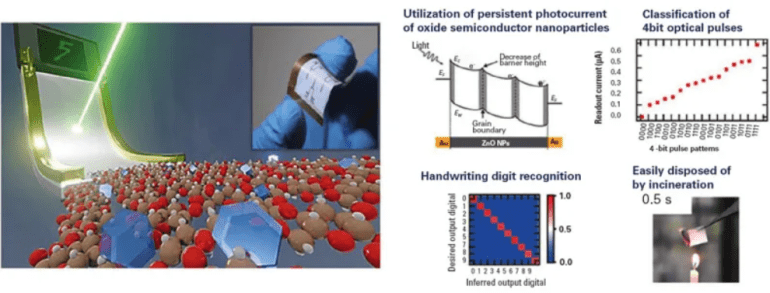- Researchers develop flexible paper-based sensor inspired by the human brain’s functionality.
- AI advancements offer transformative potential but demand massive energy consumption.
- New sensor aims to address energy costs and sustainability concerns in health monitoring.
- Sensor operates independently, consumes low power, and handles real-time biological signals.
- Utilizes nanocellulose and ZnO nanoparticles to mimic synaptic behavior for data processing.
- Demonstrates rapid response time and durability in recognizing handwritten digits.
Main AI News:
Innovations in artificial intelligence (AI) promise groundbreaking advancements across various domains, from image creation to autonomous driving. However, the immense computational power required for such feats comes at a staggering energy expense. For example, the training of OPEN AI’s GPT-3 model alone consumed a whopping 1,287 MWh, equivalent to powering an average U.S. household for 120 years. This energy demand presents a significant obstacle, especially in fields like health monitoring, where massive volumes of vital data are funneled to centralized servers for analysis. Not only does this process drain substantial energy resources, but it also raises concerns about sustainability, bandwidth congestion, and communication lag.
Efficient health monitoring and biological diagnostics demand autonomous sensors that operate independently, minimizing reliance on central servers. These sensors must consume minimal power for prolonged operation, handle dynamic biological signals for real-time monitoring, conform comfortably to the body, and offer ease of production and disposal for hygiene purposes.
Addressing these requirements, a team of researchers led by Associate Professor Takashi Ikuno from the Tokyo University of Science (TUS) has introduced a flexible paper-based sensor emulating the functionality of the human brain. Their breakthrough findings were recently unveiled in Advanced Electronic Materials on February 22, 2024.
Dr. Ikuno explains, “We have developed a paper-based optoelectronic synaptic device comprising nanocellulose and ZnO, enabling physical reservoir computing. This device exhibits synaptic behavior and cognitive functions suitable for health monitoring.”
In the human brain, information flows through networks of neurons via synapses, facilitating parallel processing and multitasking. To replicate this efficiency, the researchers engineered a photo-electronic artificial synapse device featuring gold electrodes atop a 10 μm transparent film composed of zinc oxide (ZnO) nanoparticles and cellulose nanofibers (CNFs).
The transparent film serves a triple role: facilitating light transmission for processing optical input signals, providing flexibility through cellulose nanofibers for easy disposal, and leveraging photoresponsive ZnO nanoparticles to generate a photocurrent upon exposure to pulsed UV light and constant voltage. This photocurrent mimics synaptic responses, allowing the device to interpret and process biological data received from optical sensors.
The film exhibited the ability to discern 4-bit input optical pulses, eliciting distinct currents in response to time-series optical inputs within sub-second intervals. This swift responsiveness is critical for detecting abrupt health signal variations. Moreover, the device demonstrated post-potentiation facilitation when subjected to successive light pulses, akin to short-term memory processes in the brain, thereby enhancing pattern recognition capabilities.
To validate its functionality, the researchers translated MNIST images (a dataset of handwritten digits) into 4-bit optical pulses, irradiated the film, and recorded current responses. Utilizing this data, a neural network achieved an impressive 88% accuracy in recognizing handwritten numbers.
Even after enduring 1,000 cycles of bending and stretching, the device retained its ability to recognize handwritten digits, underscoring its durability and suitability for repeated use. Dr. Ikuno concludes, “Our study underscores the potential of integrating semiconductor nanoparticles into flexible CNF films to create adaptable synaptic devices for physical reservoir computing.”
Conclusion:
The development of an AI-powered paper sensor with capabilities mirroring the human brain marks a significant milestone in health monitoring technology. This innovation not only addresses the energy demands and sustainability concerns associated with AI but also opens up new possibilities for autonomous and efficient data processing in various industries, potentially revolutionizing the market for wearable health devices and sensor technologies.

